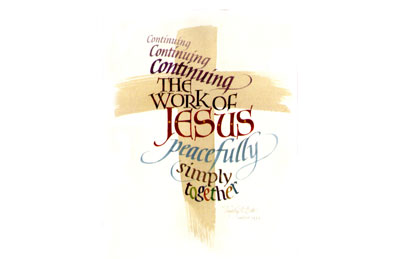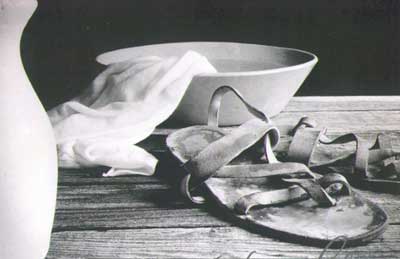
Church of the Brethren Basics
Continuing the Work of Jesus ...Peacefully. Simply. Together.
Though the Brethren as a group have existed for three hundred years, we subscribe to no formal "creed" or set of rules. We simply try to do what Jesus did. Jesus brought a message of life, love, and hope. But He offered much more than inspiring words: He understood that people's spiritual needs also include day-to-day human ones - food, health, rest, comfort, friendship, and unconditional acceptance. "I am the way," He told his followers. He showed them how to trust, how to care, and how to help. Steadily, lovingly, even radically, Jesus went about saving the world - by serving its people. Because we believe His message, we seek to do the same.
Peacefully
The Church of the Brethren is a living peace church. Our longstanding commitment to peace and justice includes a deep regard for human life and dignity. Brethren reach worldwide to help repair the ravages of poverty, ignorance, exploitation, and catastrophic events. Along with our faith, we bring food, books, classes, tools, and medicine.Whether the conflict involves warring nations, racial discord, theological disputes, a personal disagreement, or a mere misunderstanding, Brethren listen conscientiously, seek guidance in the Scriptures, and work toward reconciliation. Living peacefully, to the Brethren, means treating each person with the attentive, compassionate respect that all human beings deserve. We practice peaceful living.
Simply
Years ago, all Brethren were immediately recognizable because of their plain dress. Today's Brethren live very much in the world, work in a broad range of occupations, and make use of the latest technology.Continually, though, we try to lead a simple lifestyle. Practicing a humble nonconformity, we think carefully about our daily choices. The ideal of simplicity guides how we conduct our business, raise our children, spend our leisure time, and tend our natural resources. For the Brethren, such considerations are not a requirement, but a privilege. As we seek to live intentionally, responsibly, and simply, we find a deep sense of purpose. And we find joy.
Together
Whether worshiping, serving, learning, or celebrating, Brethren act in community. Together, we study the Bible to discern God's will; we make decisions as a group, and each person's voice matters. Twice a year during our traditional Love Feast, we gather at the table of the Lord. Because Jesus urged unity, Brethren work alongside other denominations, at home and abroad, in worldwide mission and outreach.
Another way of living
In the New Testament, the word "brethren" describes a community of men and women who chose another way of living: the way of Jesus. The Church of the Brethren began three centuries ago in Germany and still draws people who want to continue Jesus' work of faithfulness and loving service.
Our congregation welcomes all who wish to share with us in another way of living: the way of Christian discipleship, fulfillment in service and life in community.
There is so much more to know. Come and see!
Brethren Belief and Practice
Who are the Brethren?
For guidance, Brethren look to the scriptures rather than to doctrine. Our faith emphasizes compassion, peacemaking, and simplicity. We baptize those who seek to follow Jesus; we anoint for healing; and in our love feast we re-enact the Last Supper, at which Jesus washed his disciples’ feet and offered the bread and cup of communion...

History of the Church of the Brethren
In August 1708 five men and three women gathered at the Eder River in Schwarzenau for baptism, an illegal act since all had been baptized as infants. They understood this baptism as an outward symbol of their new faith and as a commitment to living that faith in community. An anonymous member of the group first baptized Mack. He, in turn, baptized the other seven. This new group simply called themselves "brethren."
Though the early Brethren shared many beliefs with other Protestants, a number of issues separated them from the state churches. Relying on the New Testament as their guide, these men and women believed that Jesus had intended for his followers a different kind of life—one based on peaceful action, plain and compassionate living, and a shared search for truth. They also shared their faith enthusiastically with others, sending evangelists to other parts of Germany, Switzerland, and the Netherlands.
Due to growing persecution and economic hardship, Brethren began emigrating to North America in 1719 under the leadership of Peter Becker. Most Brethren left Europe by 1740, including Mack, who brought a group over in 1729. The first congregation in the New World was organized at Germantown, Pa., in 1723. Soon after its formation, the Germantown congregation sent missionaries to rural areas around Philadelphia. These missionaries preached, baptized, and started new congregations.
Their zeal, honesty, and hard work drew many new members into the Brethren faith community through the 1700s. New congregations were formed in New Jersey, Maryland, and Virginia. With the promise of inexpensive land, they moved into Kentucky, Ohio, Indiana, Illinois, and Missouri after the Revolutionary War. By the mid-1800s Brethren had settled in Kansas and Iowa and eventually the West Coast.

Logo - Church of the Brethren
About the logo
The Church of the Brethren symbol upholds images of life in Jesus Christ. The cross recalls our baptism into Christ’s death and resurrection (Romans 6:4) and testifies to God’s plan to bring "all in heaven and earth . . . into a unity in Christ" (Ephesians 1:10 NEB). The circle, partially defined, represents the world into which we are sent by Christ (Matthew 28:19). The circle also affirms that as members of Christ’s body we are members one of another (Romans 12:5)—a people who confess "one Lord, one faith, one baptism" (Ephesians 4:5). The wave connotes new life in Christ, "born of water and the Spirit" (John 3:5). The wave further evokes the waters of justice (Amos 5:24), the cup of water offered in Christ’s name (Mark 9:41), the basin and towel (John 13:5), and "springs of living water" (Revelation 7:17). Images central to life in Jesus Christ thus are lifted up as images for Brethren to live by.
